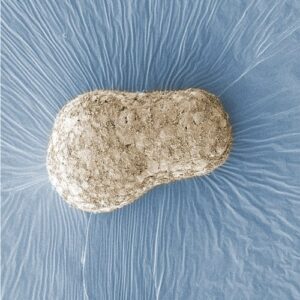A multi-disciplinary collaboration between the team of Alphée Michelot and the team of Olivia du Roure and Julien Heuvingh at the ESPCI publishes in Plos Biology a study demonstrating that the mechanical stiffness of endocytic actin patches correlates tightly with endocytosis efficiency.
Endocytosis is a cellular process during which the plasma membrane and extracellular material are internalized into the cell. A main pathway for internalization is through clathrin-mediated endocytosis, which has been shown to be a multistage process implicating more than 60 different proteins. One key protein is actin, which assembles into a patchy network of branched filaments via the actin-related protein (Arp2/3) complex. Studies have shown that this network is essential for endocytosis as any perturbation of actin assembly leads to a decrease in the rate and the efficiency of the whole process or its total failure.
A major question in the field was then to understand how actin can generate enough force to internalize the membrane, knowing that in some cells like in yeast, there is an important turgor pressure which will counteract the force generated by actin assembly. To answer this question, the two teams have developed a workflow to seek a correlation between mechanical properties of actin networks and the efficiency of endocytosis. They performed on wild-type (WT) yeast and mutant strains lacking various actin crosslinkers, a side-by-side comparison of:
1/ the rigidity of branched actin networks reconstituted in vitro from cellular extracts, measured with an original high-throughput technique based on the dipolar attraction between magnetic colloids.
2/ the corresponding endocytic phenotypes observed in vivo.
Results show that a loss of actin crosslinkers softens actin networks, directly limiting the transmission of the force to the endocytic patch and thus impairing the efficiency of the endocytic process. A direct consequence is that endocytic actin patch lifetime increases, and cells end up with an abnormal number of actin patches. This overall abnormal generation of actin filaments in cells is sufficient to deplete the cellular pool of actin monomers, which further impairs actin assembly and endocytosis. This study is therefore a good example of how a perturbation in cells such as defective actin crosslinking triggers multiple negative consequences.

To know more :
-
Mechanical stiffness of reconstituted actin patches correlates tightly with endocytosis efficiency
Jessica Planade, Reda Belbahri, Micaela Boiero Sanders, Audrey Guillotin, Olivia du Roure, Alphée Michelot, Julien Heuvingh



